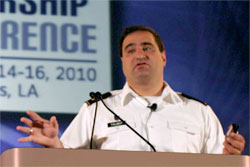The Future Is Now
<< back to Simulation National Leadership Conference 2010 Home page

Thurs. 9/16/2010 - AM
Army Maj. Thomas B. Talbot, MD, energized the audience first thing Thursday morning with his presentation "DOD Strategic Review: Where We Are, Where We Are Going." Dr. Talbot is the Portfolio Manager for Medical Modeling, Simulation and Training Telemedicine and Advanced Technology Research Center (TATRC). He was quick to compliment the VHA and the Employee Education System (EES) on their foresight in establishing SimLEARN to advance the transition to systematic use of simulation based medical education (SBME).
Dr. Talbot summarized the approach that TATRC takes in using simulation for educational purposes. TATRC analyzes the gaps between what is present and what is possible, it anticipates challenges, and it imagines the future possibilities ahead of requirements. An invigorating speaker, Dr. Talbot presented most of his content by providing the current state of simulation use, discussing the challenges, then projecting exciting future use of simulation.
He reviewed the Department of Defense (DOD) use of simulation, listing the modalities:
- task trainers
- animal systems simulation
- multimedia software
- mannequin systems
For each of these, he gave an inventory of current uses, listed the challenges, and then projected future directions. For example, gaming technology will drive the future of multimedia simulation and engage the generations who have grown up with technology. Mannequins in the future will allow for customized construction or programming (e.g., anatomy, symptoms), will become more realistic (e.g., movement, tissue, secretions), and will be responsive to human interaction (e.g., through artificial intelligence, voice recognition).
Dr. Talbot outlined the Armed Forces Simulation Initiative for Medicine (AFSIM). This initiative is rolling out through three consortia:
- Combat Casualty Training Consortium - identifies gaps in training and how simulation can help fill those gaps
- Medical practice Consortium - what training makes a physician a military physician, a nurse a military nurse; how can simulation serve military specific medical training needs?
- Patient Focused Consortium - the connection with the VA: how can technology meet the needs of the patients?
Regarding this last consortium, for example, simulation can assist with an individual's physical therapy, with responsive human-machine interfaces, and with behavioral counseling and psychological health programs.
With his knowledge of the industry, Dr. Talbot was particularly animated in describing the exciting changes he is anticipating. He looks forward to human-machine interfaces that are location- and context- sensitive, that sense a user's physical motion, facial expressions, and tone-of-voice, and portray increased graphical realism and increased "emotion." These future elements will be instrumental in the constant evolution of SBME, and provide rich possibilities for VHA.



















